
Caladenia saccharata, commonly known as sugar orchid, is a species of flowering plant in the orchid family, Orchidaceae and is endemic to the south-west of Western Australia. It has a single leaf and a single flower with three white sepals and two similar petals.
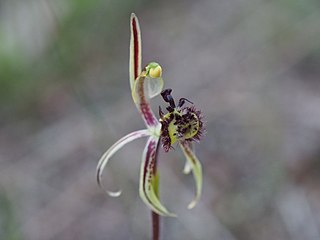
Caladenia barbarossa, commonly known as the common dragon orchid is a species of orchid endemic to the south-west of Western Australia. It can be distinguished by its distinctive labellum which is attractive to species of male thynnid wasps.

Caladenia huegelii, commonly known as the grand spider orchid is a species of orchid endemic to the south-west of Western Australia. It has a single, hairy leaf and up to three relatively large red, green and cream-coloured flowers which have "split-hairs" on the sides of the labellum.

Caladenia multiclavia, commonly known as the lazy spider orchid is a species of orchid, endemic to the south-west of Western Australia. It has a single, hairy leaf and one or two greenish-yellow, red and cream-coloured flowers resembling a reclining spider. Although it usually only has a single flower, it often grows in clumps of up to six plants.
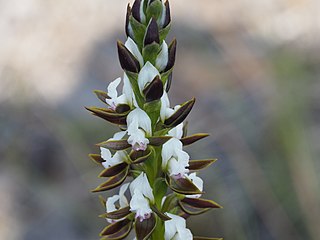
Prasophyllum sargentii, commonly known as the frilled leek orchid, is a species of orchid endemic to the south-west of Western Australia. It is a tall orchid with a single smooth, tubular leaf and up to thirty or more purplish and white or golden brown and white flowers with a frilled labellum.
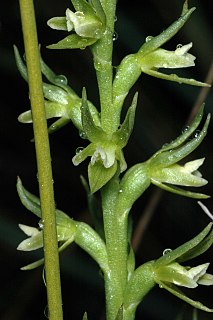
Prasophyllum lindleyanum, commonly known as the green leek orchid, is a species of orchid endemic to south-eastern Australia. It has a single smooth, tube-shaped leaf and up to twenty scented, greenish flowers with a greenish or white labellum with a pink tinge.
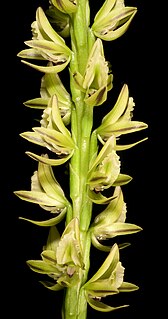
Prasophyllum brownii, commonly known as the Christmas leek orchid, is a species of orchid endemic to the south-west of Western Australia. It is one of the last of the genus in Western Australia to flower and has a tall flowering stem with up to eighty pale green and fawn-coloured flowers.
Prasophyllum cucullatum, commonly known as the hooded leek orchid, is a species of orchid endemic to the south-west of Western Australia. It is a tall orchid with a single smooth, tubular leaf and up to fifty or more purplish-red and white flowers with a frilled labellum crowded along a relatively short flowering stem.
Prasophyllum drummondii, commonly known as the swamp leek orchid, is a species of orchid endemic to the south-west of Western Australia. It is a late-flowering species with a single tubular leaf and up to thirty brownish-orange or pale yellow flowers and often grows in standing water.
Prasophyllum gibbosum, commonly known as the humped leek orchid, is a species of orchid endemic to the south-west of Western Australia. It is a late-flowering leek orchid with a single smooth, tubular leaf and up to eighty or more purplish-red and white flowers with a smooth labellum. It is similar to P. cucullatum but that species has a frilly labellum, usually a shorter flowering stem and an earlier flowering period.
Prasophyllum giganteum, commonly known as the bronze leek orchid, is a species of orchid endemic to the south-west of Western Australia. It is a tall, fragrant leek orchid with a single smooth, tubular leaf and up to fifty or more green and pinkish-purple flowers with a frilly labellum.
Prasophyllum gracillimum, commonly known as the slender leek orchid, is a species of orchid endemic to a small region of Western Australia. It has a single tubular green leaf, and green, brown and white flowers loosely arranged along the flowering stem. This species has not been seen for more than fifty years and is considered by some botanists to be a form of P. fimbria.
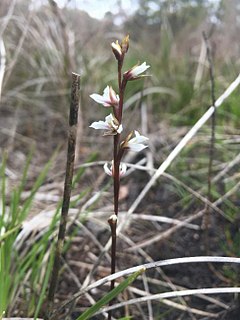
Prasophyllum hians, commonly known as the yawning leek orchid, is a species of orchid endemic to the south-west of Western Australia. It is a common, tall leek orchid with a single smooth, tubular leaf and up to fifty or more pink and fawn flowers with a frilly labellum.
Prasophyllum macrotys, commonly known as the inland leek orchid, is a species of orchid endemic to the south-west of Western Australia. It has a single tubular leaf and up to thirty greenish to purplish flowers and is similar to the tall leek orchid but has smaller, darker flowers.
Prasophyllum odoratissimum, commonly known as the scented leek orchid or fragrant leek orchid, is a species of orchid endemic to Western Australia. It has a single smooth, tubular leaf and up to thirty or more scented, greenish, white and fawn-coloured flowers with a labellum which is often bent backwards. It was formerly included in Prasophyllum odoratum.
Prasophyllum ovale, commonly known as the little leek orchid, is a species of orchid endemic to the south-west of Western Australia. It is a small leek orchid with a single smooth, tubular leaf and up to twenty or more white, green and brown flowers with the labellum only slightly upturned.
Prasophyllum paulinae, commonly known as Pauline's leek orchid, is a species of orchid endemic to the south-west of Western Australia. It is a small, rare leek orchid with a single smooth, tubular leaf and up to seventy yellowish-green and purple flowers.
Prasophyllum plumiforme, commonly known as the dainty leek orchid, is a species of orchid endemic to the south-west of Western Australia. It is a small leek orchid with a single smooth, tubular leaf and up to fifty or more tiny cream-coloured or greenish-yellow flowers on a tall flowering stem.
Microtis brownii, commonly known as the sweet mignonette orchid or sweet onion orchid, is a species of orchid endemic to the south-west of Western Australia. It has a single hollow, onion-like leaf and up to sixty small, green and white scented flowers well-spaced along the flowering stem. It usually grows in swampy places, flowers more prolifically after summer fires and sometimes forms very large colonies.

Thelymitra benthamiana, commonly called the leopard sun orchid or blotched sun orchid, is a species of orchid in the family Orchidaceae and is endemic to Australia. It has a single leathery leaf and up to ten yellowish green flowers with brownish spots, blotches and patterns. The column is yellow with deeply fringed wings and the lobe on top of the anther has a large lump on its top.






















